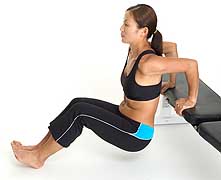I am not going to lie, I think steady state cardio is a total waste of time. I’d rather watch “Titanic” for a week straight than perform any steady state cardio (I’ll never let go Jack!”) Yet walk into any gym in North America and you will undoubtedly see everyone and their mother on the treadmill or elliptical trainer chugging along while watching their favorite shows on the television in the hopes of shedding that extra body fat. These are the same people who look the same now as they did three years ago. These are the same people who rarely ever get results and will try every fad diet out there. In the end, they will conclude that they’re just genetically predisposed to being fat. On the contrary, they’re just predisposed to being lazy and the REAL reason they never see results is because they don’t want to work hard. Sorry but people need some tough love from time to time.
Have you ever noticed that the leanest people in the gym lift weights, and perform intervals? On the flip side, ever notice where all the “out of shape” people tend to hang out in the gym? You guessed it: treadmills, elliptical trainers, and bikes.
Shedding body fat is NOT about how many calories you burn in a 45 minute session on the treadmill. It’s true, your body burns a greater percentage of fat while doing low intensity exercise (matter of fact your body is burning body fat while you read this blog). But even if you burned 90% fat during these marathon sessions of cardio, the amount of TOTAL calories being burned is insignificant. 90% of nothing, is still nothing.
The REAL secret to shedding body is providing enough of a metabolic disturbance so that the body will be burning calories OUTSIDE of the gym. Like I alluded to above, it’s not about how many calories you burn in an hour at the gym; it’s about how many calories your body is burning while you’re NOT in the gym.
Interval training is simply alternating periods of “work” with periods of “rest.” Yes, it’s that simple. The basic tenets of interval training can be satisfied on the treadmill, stationary bike, stairmaster, or elliptical, but performing outside on a track is probably the most effective. The work component represents the high intensity/sprint component, and the rest component represents the low intensity/active recovery component. For example, alternating 20 second sprints/fast runs with 60 second brisk walks (or jogs) until the desired time as elapsed.
Benefits of Intervals:
1. Greater Energy Expenditure and Resultant Fat Loss
With increasing exercise intensities, the proportion of energy substrate derived from fat decreases, while the proportion of carbohydrate usage increases. However, the predominant fuel substrate used during exercise does not play a significant role in fat loss. Total daily energy expenditure is more important for fat loss than the major fuel used during exercise. Many studies have compared interval training to endurance cardio and concluded that interval training is the most optimal method for fat loss.
One study had subjects engage in either an endurance program (4-5 times per week for 30-45 minutes) for 20 weeks or a high-low intensity program (interval) for 15 weeks.
Neither group was placed on a diet.
The endurance group expended more overall calories during their session compared to the high-low (interval) group. Actually, the endurance group expended almost DOUBLE the calories.
However, the decrease in six subcutaneous skin folds was greater in the high-low intensity group than it was in the endurance group. This is despite the lower energy cost during exercise.
After statistical analysis it was shown that the high-low intensity group experienced nine times the fat loss of the endurance group; even with 5 LESS weeks of total exercise.
This same study found the high-low intensity protocol to significantly increase the activity of an enzyme which is a marker of the activity of ‘fat burning’ over endurance protocol.
2. Improved Cardiovascular Conditioning and Fitness
Interval training has been shown to increase both aerobic and anaerobic capacity whereas endurance cardio only increases aerobic capacity.
It is well established that interval training increases aerobic capacity/VO2 max more than endurance cardio. And in all actuality, the fastest way to improve one’s VO2 max (the standard measure of AEROBIC fitness) is through interval training. How you like dem apples?
As Mike Boyle has stated on several occasions, conventional aerobic training is popular because it’s easy. Interval training is hard and uncomfortable. Ask anyone if they had a choice between going for a 30 minute jog or performing five, 400m tempo runs under 70 seconds, which would they choose? More often than not they will choose the former.
If you want to shed body fat, you need to WORK and work hard. Stop with the drawn out steady state cardio and begin to implement more intervals/sprints into your repertoire. You can thank me later.





